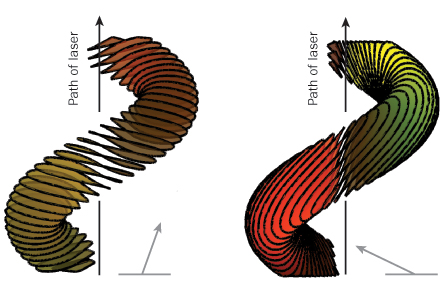
Another piece of Star Trek technology has become a reality. Captain Kirk would instantly recognize new blueprints developed by a team of Chinese scientists as plans for a tractor beam.
The proposed device hasn’t yet been built. But a similar one conceived by an American physicist was tested last year. Each device would fulfill the science fiction dream of reeling in objects using light — though neither could move anything bigger than a bacterium, much less a starship.
The Chinese plan, reported online February 24 at arXiv.org, would use a laser to produce what is called a Bessel beam. This beam, unusual because it remains focused over large distances, could induce electric and magnetic fields in an object in its path. The spray of light scattered forward by these fields could push the object backward, against the movement of the beam itself. “This analysis established that light can indeed pull a particle…. Under appropriate conditions a [Bessel beam] can act as an ‘optical tractor beam,’” write physicist Jun Chen of Fudan University in Shanghai and colleagues.
Physicist David Grier of New York University believes that the Chinese plan would work. And Grier should know: he designed his own tractor beam and built it, demonstrating for the first time that a beam of light can tug objects over long distances. His paper was published in the March 29, 2010, Optics Express.
“Both of these papers give us new tools,” says Phil Jones, a physicist at University College London. “Something like this would have useful applications for moving particles. The effects are also quite size-dependent, so they might also be useful for sorting particles of different sizes.”
A beam of light that can pull is counterintuitive to physicists, who have spent centuries studying light’s ability to push.
“You normally think of light as being like a fire hose that just blows you downstream,” says Grier. That’s because when particles of light strike an object, they rebound like Ping-Pong balls and give a weak nudge. This radiation pressure is thought to shape the tails of comets and is useful for pushing solar sails in space.
The invention of the laser provided scientists with a stronger source of light and a push that could do useful work on Earth. Researchers now routinely use optical tweezers based on this push to pin down and manipulate atoms and small objects. But turning this push into a pull required more sophisticated optics — in Grier’s case, a solenoid beam. Unlike traditional lasers, which are bright in the middle and dimmer at the edges, a solenoid beam contains a bright spiral of intense energy.
This corkscrew of energy tends to attract small spheres made of silica. The light in the corkscrew can then be tilted at an angle that kicks the spheres backward even as the beam itself moves forward. Like a tennis player sprinting away from the net while deftly lobbing the ball back at an opponent, this tilt can potentially push an object all the way back to the beam’s source. Or it can be rotated to push forward. Switching between these states allows Grier to move objects back and forth.
The force of this push and pull, limited by the laser’s strength and the speed of light, is small. But it’s enough to tug 1.5-micrometer-wide spheres a distance of about 8 micrometers — with much larger distances theoretically possible.
“You’d need a terawatt [or trillion-watt] laser to pull a person,” says Grier. Being struck by that much energy, though, would likely incinerate the person being pulled. “It would be a short trip.”
In a new paper to appear in an upcoming issue of Optics Express, Grier describes new schemes for his tractor beam that even Mr. Scott couldn’t imagine. Instead of pulling objects along a simple straight line, Grier has begun to explore curves, loops and even knotted paths that cross themselves.
As a first demonstration, he guided spheres around ring-shaped tracks tilted in different three-dimensional orientations. This particle puppeteering, he says, could be useful in generating plasma currents to stabilize fusion power-generation technologies.
TWIST AND PULL from Science News on Vimeo.
Unlike traditional laser beams, solenoid beams in proposed tractor-beam devices contain a bright spiral of energy woven into their light, shown in this video.
Credit: David Grier/New York University







